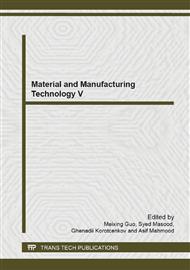p.162
p.169
p.174
p.179
p.183
p.188
p.195
p.199
p.205
Characterization and Comparison of Thermally Sprayed Hard Coatings as Alternative to Hard Chrome Plating
Abstract:
Thermal spray coatings have become one of the most potential for hard chrome replacement, particularly for wear and corrosion applications. In this study four types of hard coating materials were selected and thermally sprayed by suitable processes as the following designated codes (material/spray technique): Cr-Fe/HVOF, Cr-Ni/HVOF, WC-Ni/SF and Cr-Fe/AS. All of starting materials were characterized in order to create a correlation between spray materials and coating characteristics. SEM was employed for morphology and microstructure investigation. Particle size analysis was investigated by SEM and laser particle size analyzer. Coating characterization included surface roughness measurment by profilometer, porosity evaluation by image analysis and hardness test by Vicker microhardness tester. Microstructure of coatings was also revealed by SEM. Wear performance was evaluated by pin on disc test and dry sand rubber wheel abrasion test. Corrosion resistance was tested by potentiodynamic method. The results showed that particle size and morphology of starting powders were various depending on manufacturing method. Chemical compositions of starting materials showed great effect on coating properties and performance. Coatings deposited by HVOF and spray & fuse (SF) method showed typically dense and homogeneous structure than arc sprayed coating. WC-Ni/SF coating showed lowest abrasive wear rate compared to other thermally sprayed coatings. All Ni base coatings had significantly lower corrosion rates while Cr-Ni/HVOF coating had lowest corrosion rate. Although Cr-Ni/HVOF and WC-Ni/SF could be applicable for both wear and corrosion applications, for heat sensitive parts, Cr-Ni/HVOF coating could be a better alternative to spray and fuse.
Info:
Periodical:
Pages:
183-187
Citation:
Online since:
June 2014
Authors:
Keywords:
Price:
Сopyright:
© 2014 Trans Tech Publications Ltd. All Rights Reserved
Share:
Citation:


